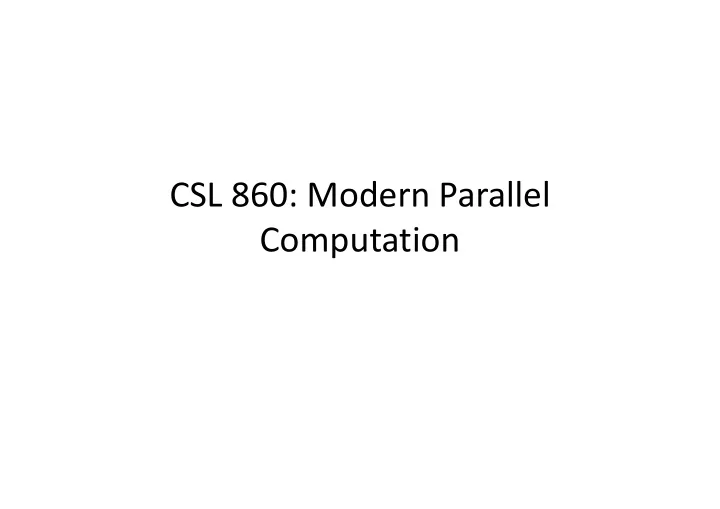

CSL 860: Modern Parallel Computation Computation
Course Information • www.cse.iitd.ac.in/~subodh/courses/CSL860 • Grading: – Quizes 25 – Lab Exercise 1 7 + 8 – Project 35 (25% design, 25% presentations, 50% Demo) – Final Exam 25 Verbal discussion of assignments is fine but looking at someone else's work and then doing your own is not. Letting your work become available or visible to others is also cheating . For your project, you may borrow code available online but must clearly identify such code with due reference to the source. First instance of cheating will invite a zero in the assignment and a letter grad penalty. Repeat offender will fail the course.
Course Material • Documents posted on the course website • Reference books: – Introduction to Parallel Computing by Grama, Gupta, Karypis & Kumar by Grama, Gupta, Karypis & Kumar – An introduction to Parallel Algorithms by Jaja – Parallel Programming in C with MPI and OpenMP by Quinn
What this course is about? Learn to solve problems in parallel • – Concurrency issues – Performance/Load balance issues – Scalability issues Technical knowledge • – Theoretical models of computation – processor architecture features and constraints – processor architecture features and constraints – programming API, tools and techniques – Standard algorithms and data structures Different system architecture • – Shared memory, Communication network Hand-on • – Lots of programming – Multi-core, massively parallel – OpenMP, MPI, Cuda
Programming in the ‘Parallel’ • Understand target model (Semantics) – Implications/Restrictions of constructs/features • Design for the target model – Choice of granularity, synchronization primitive – Usually more of a performance issue Usually more of a performance issue • Think concurrent – For each thread, other threads are ‘adversaries’ • At least with regard to timing – Process launch, Communication, Synchronization • Clearly define pre and post conditions • Employ high-level constructs when possible – Debugging is extra-hard
Serial vs parallel • ATM Withdrawal Withdraw(int acountnum, int amount) { cur balance = balance(accountnum) ; if(curbalance > amount) { if(curbalance > amount) { setbalance(accountnum, curbalance-amount); eject(amount) } else … }
Some Complex Problems N -body simulation • – 1 million bodies � days/iteration Atmospheric simulation • – 1km 3D-grid, each point interacts with neighbors – Days of simulation time Movie making Movie making • – A few minutes = 30 days of rendering time Oil exploration • – months of sequential processing of seismic data Financial processing • – market prediction, investing Computational biology • – drug design – gene sequencing (Celera)
Why Parallel • Can’t clock faster • Do more per clock – Execute complex “special-purpose” instruction – Execute more simple instructions Execute more simple instructions
Measuring Performance • How fast does a job complete – Elapsed time (Latency) – compute + communicate + synchronize • How many jobs complete in a given time How many jobs complete in a given time – Throughput – Are they independent jobs?
Learning Parallel Programming • Let compiler extract parallelism? – Some predictive-issue has succeeded – In general, not successful so far – Too context sensitive – Many efficient serial data structures and algorithms are – Many efficient serial data structures and algorithms are parallel-inefficient – Even if compiler extracted parallelism from serial code, it would not be what you want • Programmer must conceptualize and code parallelism • Understand parallel algorithms and data structures
Parallel Task Decomposition Data • Data Parallel Parallel – Perform f (x) for many x • Task Parallel – Perform many functions f i Perform many functions f Task Parallel Pipeline
Fundamental Issues • Is the problem amenable to parallelization? – Are there (serial) dependencies • What machine architectures are available? – Can they be re-configured? Can they be re-configured? – Communication network • Algorithm – How to decompose the problem into tasks – How to map tasks to processors
Parallel Architectures: Flynn’s Taxonomy MISD MIMD Many ams Instruction Streams SISD SIMD 1 Many 1 Data Streams
Parallel Architectures: Components • Processors • Memory – shared – distributed • Communication Communication – Heirarchical, Crossbar, Bus, Memory – Synchronization • Control – centralized – distributed
Formal Performance Metrics Exec time using 1 processor system ( T 1 ) Speedup, S ( p ) = Exec time using p processors ( T p ) Optimal if C p = T 1 S p Efficiency = p Look out for slowdown : T 1 = n 3 Cost, C p = p × T p T p = n 2.5 , for p = n 2 C p = n 4.5
Amdahl’s Law • f = fraction of the problem that is sequential � (1 – f ) = fraction that is parallel • Parallel time T p f ( − 1 f ) p = + p • Speedup with p processors: 1 S p = 1 f − f + p
Amdahl’s Law • Only fraction (1- f) shared by p processors f Increasing p cannot speed-up fraction f • Upper bound on speedup at p = ∞ 1 1 S p S = Converges to 0 = 1 f − ∞ f f + p Example: f = 2%, S ∞ = 1 / 0.02 = 50
Recommend
More recommend